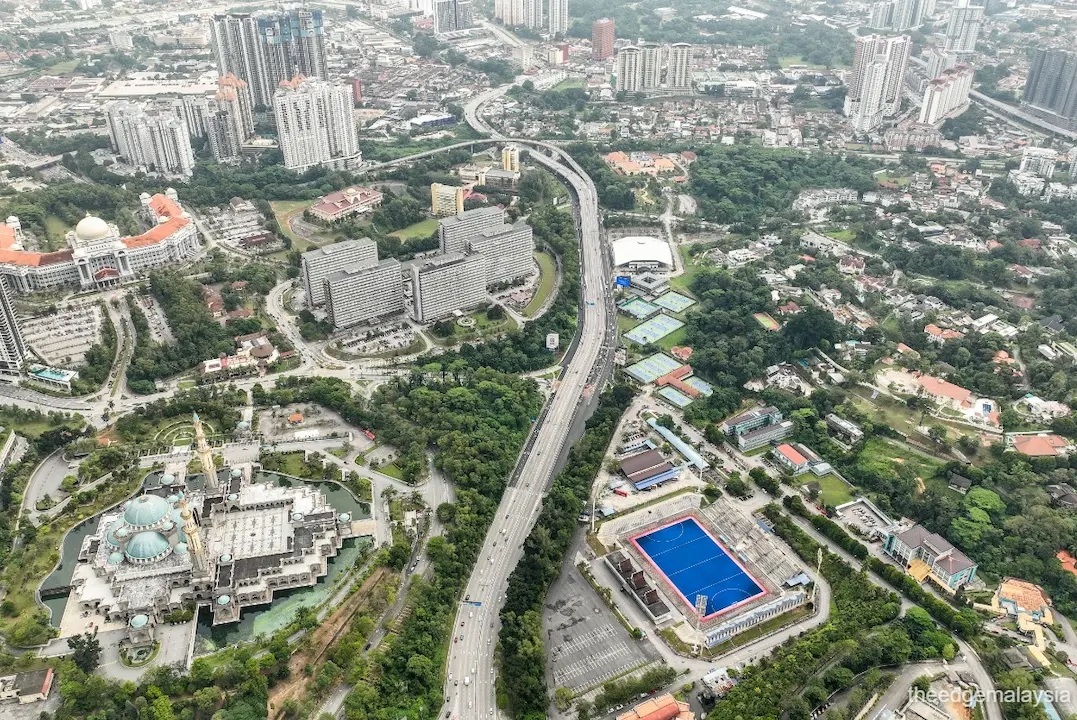
- Speaking on behalf of Semantan Estate (1052) Sdn Bhd during court proceedings on Thursday, senior counsel Datuk Dr Cyrus Das said the court must decide whether it can "regularise" an acquisition irregularity that has been declared illegal by the High Court, Court of Appeal (COA) and the Federal Court. That is why the 70-year-old Semantan Estate (1052) Sdn Bhd debacle has to be heard on the merits of its appeal, he said.
PUTRAJAYA (Nov 6): A decades-long legal battle over unlawful government land acquisition must be resolved by the Federal Court as it directly impacts citizens' constitutional right to property, senior counsel Datuk Dr Cyrus Das argued before the apex court on Thursday.
Speaking on behalf of Semantan Estate (1052) Sdn Bhd during court proceedings on Thursday, Das said the court must decide whether it can "regularise" an acquisition irregularity that has been declared illegal by the High Court, Court of Appeal (COA) and the Federal Court. That is why the 70-year-old Semantan Estate (1052) Sdn Bhd debacle has to be heard on the merits of its appeal, he said.
The origins of this dispute trace back to 1956, when the government took possession of the 263.272-acre land in Bukit Semantan, Kuala Lumpur, for RM1.325 million. The land was subsequently developed into the prestigious Duta Enclave, which now houses government buildings, facilities, and a major system of roads. Semantan Estate then filed a suit over the case in 2003, alleging that the compulsory land acquisition was illegal because it was conducted without following the proper legal procedures and amounted to trespassing.
The company won the suit at the High Court in 2009, and this win was upheld all the way to the Federal Court in 2012. Following this victory, High Court in August 2024 granted an order for the return of the land and the title to Semantan Estate. However, the government successfully appealed this order at the Court of Appeal in June this year, resulting in the land and title not being returned. Semantan Estate is now seeking to challenging this at the Federal Court.
Das argued that the government, as the primary enforcer of law in the country, should be the first to comply with any court order to uphold the judicial system's integrity and set an example for the citizens.
Yet, since the High Court's 2009 decision that found the government had trespassed on the land, followed by the upper court's affirmations that the land acquisition was illegal—Semantan has not been able to enforce the decision due to the government's non-compliance, he said. "As a result, Semantan has to file two applications for a physical return of the land and the buildings on it, together with the land title under the National Land Code in 2017," he said.
The case is important as not only does it affect the rights of property of private citizens, it also determines whether the courts have the power to retroactively make an illegal act legal by simply declaring that compensation is the only available remedy, he said.
This is because while the High Court ruling in 2009 gave Semantan Estate the right to possession—to get the land back—the COA changed this order and replaced the physical return of the land with a payment of compensation, Das argued. This, in essence, "regularises the irregularity" by treating the government's illegal act of trespassing as if it were a legal action.
In 2009, judge Zura Yahya, who presided over the case at the High Court, ruled that the government had trespassed on the land, and that Semantan Estate retained “beneficial interests” on the land. The decision was upheld by the COA and the Federal Court in 2012. The government tried but failed to get the case reviewed in 2019 by the Federal Court.
The declaratory relief, Das contended, cannot be changed or supplemented by the COA with adequate compensation in its June ruling this year, as Zura’s original decision had been upheld by both the COA and apex court in 2012. Doing so would violate the principle of stare decisis, which means to stand by things that have been decided.
He further questioned what constituted "adequate compensation", arguing it could not be based on the 1956 land acquisition rate, which the COA ruled in its June verdict.
Co-counsel Ira Biswas, who appeared with Alexie Ng Ying Ching, said Zura’s High Court order meant that their client is entitled to get the land title and the physical transfer of the land, together with compensation for the inadequate land acquisition and mesne profit — payment from the government for continuing to occupy the land.
Questions posed met appeal threshold, Semantan Estate argues
Hence, Das said the 26 questions posed by Semantan Estate, which has gone under involuntary liquidation, are novel as it touches on Article 13, which involves the constitutional rights to property. It also touches on two pre-Merdeka laws:
i) Section 29(1)(b) of the Government Proceedings Act 1956 (GPA): This bars individuals from recovering land from the government, stipulating that the court may only make declaratory orders on compensation.
ii) Section 8(1) of the Specific Relief Act 1950 (SPA): This prevents a suit over the disposition of land or assets from being brought against the government.
Das asserted that the questions posed by his client have also met the threshold under Section 96(a) and (b) of the Courts of Judicature Act 1964, as they are not only novel but are also questions of law that warrant further argument, as well as being questions concerning the effect of a constitutional provision, and that a Federal Court's decision would benefit the public.
He also highlighted that the apex court has never before decided on Article 13, alongside Section 29(1)(b) of the GPA.
Among the 26 questions are two that touch on constitutional issues:
—As the court had ruled the government had taken the land unlawfully and the landowner is entitled to possession of the land, does Article 13 permit the government to keep the land by the payment of compensation?
—Does Article 13 permit the court to order compensation for the compulsory taking of land from a landowner, where it has been determined that there was non-compliance with the applicable law for compulsory acquisition?
Government's argument and judicial view
At the start of proceedings, the bench, comprising Chief Judge of Malaya Tan Sri Hasnah Mohamed Hashim, Federal Court judge Datuk Hanipah Farikullah, and Court of Appeal Judge Datuk Che Mohd Ruzima Ghazali, refused Das' request for an enlarged bench of five judges.
Hasnah and Hanipah also posed numerous questions to Das about the case.
Senior federal counsel Shamsul Bolhassan, who appeared with Ahmad Hanir Hambaly @ Arwi for the government, objected to Semantan Estate’s leave by arguing there was nothing peculiar or novel in the questions the company posed. He also argued that challenges to the pre-Merdeka laws and constitutional rights under Article 13 had already been previously decided.
Shamsul also said Semantan Estate’s contention that the COA decision in June had improperly altered the 2009 High Court Order is misconceived.
“Firstly, the government respectfully submitted that the COA did not in any manner alter or interfere with the first limb of the 2009 High Court Order. The 2009 High Court Order granted only a declaration, consistent with the restriction imposed under Section 29(1)(b) of the GPA,” he added.
For these reasons, Shamsul said the appellate court rightfully declared that Semantan Estate was only entitled to compensation and not the land back.
COA's reasoning in its June verdict
In allowing the government’s appeal in June against the High Court's order in August last year for the Federal Territory Land Registrar to transfer the land title of the 263.272-acre "Duta Enclave" back to Semantan Estate, the COA ruled that Semantan Estate is not entitled to the land title or physical land due to the two pre-Merdeka laws.
Datuk Lee Swee Seng—now Federal Court judge—in reading out the COA's unanimous decision, said the words in the two laws meant exactly what they say, that there is a prohibition, and that no order is to be made for the recovery of the land.
“This is to ensure a public authority can perform its duty and obligation. Even if the government is supposed to pay, the acquisition is considered to be lawful,” Lee said.
Lee further described that the consequence would be “horrendous” if an order was issued to return the land to Semantan Estate after nearly 70 years. He also pointed out that when the government took possession of the plot in December 1956, the area only consisted of old rubber trees.
“Now, it is part of a fully developed township with various government buildings housing various facilities that serve the public ... there is also a system of roads, highways and flyovers serving the public and connecting it with the surrounding areas, all developed and continue to be developed,” Lee noted.
Following the COA's decision, Semantan Estate filed an application for leave (permission) to appeal to the Federal Court. Thursday's hearing before the panel was specifically to argue that the questions posed by the company meet the stringent legal threshold required for the apex court to hear the case on its full merits.
Decision on Nov 13
On hearing Thursday's submissions, Hasnah said the bench would need time before delivering its decision and set Thursday (Nov 13) for the verdict.
Incidentally, Hasnah is scheduled to retire on Nov 15, with Hanipah to follow later this month.
Also present at the proceedings was Malaysian Bar representative Datuk Malik Imtiaz Sarwar, who supported that merits of the Semantan Estate case be heard. He said the case would not only decide on property rights, but also provide guidelines on judicial review proceedings, claiming the June COA judgement had affected the right to review.
As Penang girds itself towards the last lap of its Penang2030 vision, check out how the residential segment is keeping pace in EdgeProp’s special report: PENANG Investing Towards 2030.





